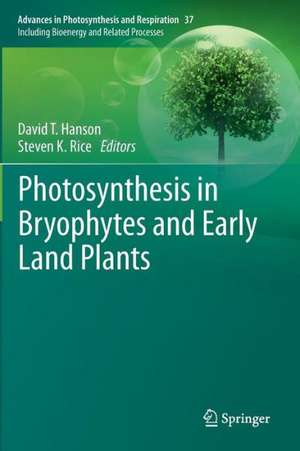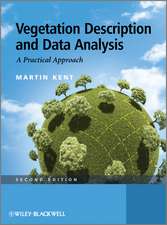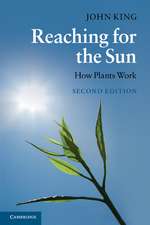Photosynthesis in Bryophytes and Early Land Plants: Advances in Photosynthesis and Respiration, cartea 37
Editat de David T. Hanson, Steven K. Riceen Limba Engleză Hardback – 5 noi 2013
| Toate formatele și edițiile | Preț | Express |
|---|---|---|
| Paperback (1) | 1224.68 lei 6-8 săpt. | |
| SPRINGER NETHERLANDS – 23 aug 2016 | 1224.68 lei 6-8 săpt. | |
| Hardback (1) | 1232.26 lei 6-8 săpt. | |
| SPRINGER NETHERLANDS – 5 noi 2013 | 1232.26 lei 6-8 săpt. |
Din seria Advances in Photosynthesis and Respiration
- 24%
 Preț: 1620.56 lei
Preț: 1620.56 lei - 18%
 Preț: 2566.01 lei
Preț: 2566.01 lei - 18%
 Preț: 1397.68 lei
Preț: 1397.68 lei - 18%
 Preț: 1855.74 lei
Preț: 1855.74 lei - 18%
 Preț: 1850.52 lei
Preț: 1850.52 lei - 24%
 Preț: 1053.55 lei
Preț: 1053.55 lei - 24%
 Preț: 1601.76 lei
Preț: 1601.76 lei - 24%
 Preț: 1596.40 lei
Preț: 1596.40 lei - 18%
 Preț: 1234.46 lei
Preț: 1234.46 lei - 18%
 Preț: 1830.17 lei
Preț: 1830.17 lei - 18%
 Preț: 1226.60 lei
Preț: 1226.60 lei - 18%
 Preț: 1239.85 lei
Preț: 1239.85 lei - 24%
 Preț: 3132.26 lei
Preț: 3132.26 lei - 18%
 Preț: 1851.00 lei
Preț: 1851.00 lei - 18%
 Preț: 1865.68 lei
Preț: 1865.68 lei - 18%
 Preț: 1858.91 lei
Preț: 1858.91 lei - 24%
 Preț: 1095.62 lei
Preț: 1095.62 lei - 24%
 Preț: 1593.45 lei
Preț: 1593.45 lei - 24%
 Preț: 1668.27 lei
Preț: 1668.27 lei - 24%
 Preț: 1979.64 lei
Preț: 1979.64 lei - 24%
 Preț: 1570.78 lei
Preț: 1570.78 lei - 24%
 Preț: 1071.11 lei
Preț: 1071.11 lei - 24%
 Preț: 1065.34 lei
Preț: 1065.34 lei - 24%
 Preț: 1062.75 lei
Preț: 1062.75 lei - 24%
 Preț: 1060.87 lei
Preț: 1060.87 lei - 24%
 Preț: 1125.56 lei
Preț: 1125.56 lei - 18%
 Preț: 1239.37 lei
Preț: 1239.37 lei
Preț: 1232.26 lei
Preț vechi: 1502.76 lei
-18% Nou
Puncte Express: 1848
Preț estimativ în valută:
235.91€ • 246.14$ • 197.75£
235.91€ • 246.14$ • 197.75£
Carte tipărită la comandă
Livrare economică 12-26 martie
Preluare comenzi: 021 569.72.76
Specificații
ISBN-13: 9789400769878
ISBN-10: 9400769873
Pagini: 500
Ilustrații: XXVII, 342 p. 75 illus., 30 illus. in color.
Dimensiuni: 178 x 254 x 22 mm
Greutate: 0.86 kg
Ediția:2014
Editura: SPRINGER NETHERLANDS
Colecția Springer
Seria Advances in Photosynthesis and Respiration
Locul publicării:Dordrecht, Netherlands
ISBN-10: 9400769873
Pagini: 500
Ilustrații: XXVII, 342 p. 75 illus., 30 illus. in color.
Dimensiuni: 178 x 254 x 22 mm
Greutate: 0.86 kg
Ediția:2014
Editura: SPRINGER NETHERLANDS
Colecția Springer
Seria Advances in Photosynthesis and Respiration
Locul publicării:Dordrecht, Netherlands
Public țintă
ResearchCuprins
From the Series Editors.- Preface.- The Editors.- Contributors.- Author Index.- 1. What Can We Learn From Bryophyte Photosynthesis?; David T. Hanson, Steven K. Rice.- 2. Early Terrestrialization: Transition From Algal to Bryophyte Grade; Linda Graham et al.- 3. Photosynthesis in Early Land Plants: Adapting to the Terrestrial Environment; John A. Raven, Dianne Edwards.- 4. The Diversification of Bryophytes and Vascular Plants in Evolving Terrestrial Environments; Michael C. F. Proctor.- 5. Best Practices for Measuring Photosynthesis at Multiple Scales; Steven K. Rice, J. Hans C. Cornelissen.- 6. Diffusion Limitation and CO2 Concentrating Mechanisms in Bryophytes; David T. Hanson et al.- 7. Sunsafe Bryophytes: Photoprotection from Excess and Damaging Solar Radiation; Sharon A. Robinson, Melinda J. Waterman.- 8. Chloroplast Movement in Higher Plants, Ferns and Bryophytes: A Comparative Point of View; Martina Königer.- 9. Scaling Light Harvesting from Moss “Leaves” to Canopies; Ülo Niinemets, Mari Tobias.- 10. Structural and Functional Analysis of Bryophyte Canopies; Steven K. Rice et al.- 11. Genetics and Genomics of Moss Models: Physiology Enters the 21st Century; David J. Cove, Andrew C. Cuming.- 12. Photosynthesis in Aquatic Bryophytes; Janice M. Glime.- 13. Physiological Ecology of Peatland Bryophytes; Tomáš Hájek.- 14. Interacting Controls on Ecosystem Photosynthesis and Respiration in Contrasting Peatland Ecosystems; Lawrence B. Flanagan.- 15. Physiological Ecology of Tropical Bryophytes; Sebastian Wagner et al.- 16. Physiological Ecology of Dryland Biocrust Mosses; Kirsten K. Coe et al.- 17. Dominating the Antarctic Environment: Bryophytes in a Time of Change; Jessica E. Bramley-Alves et al.- 18. Opportunities in Bryophyte Photosynthesis Research; Steven K. Rice, David T. Hanson.- Subject Index.
Recenzii
“I recommend this book for researchers in the field of not only bryology but also the evolutionary history of land plants, photosynthesis in non-seed plants, and adaptations to living in extreme environments. Additionally, I recommend this book to libraries at Universities with advanced undergraduate and graduate students in Plant Biology (Botany), Plant Sciences, General Biology, and Biotechnology. For many of us, it can be refreshing to be reminded of the importance and broad utility of organisms besides Arabidopsis.” (Robert R. Wise, Photosynthesis Research, Vol. 127, 2016)
“Photosynthesis in Bryophytes and Early Land Plants is aimed at researchers, graduate students, and advanced undergraduates. I recommend this well-designed volume for those scientists, or indeed for anyone interested in the current status of bryophyte research.” (Robert R. Wise, Plant Science Bulletin, Vol. 61 (1), 2015)
“Photosynthesis in Bryophytes and Early Land Plants is aimed at researchers, graduate students, and advanced undergraduates. I recommend this well-designed volume for those scientists, or indeed for anyone interested in the current status of bryophyte research.” (Robert R. Wise, Plant Science Bulletin, Vol. 61 (1), 2015)
Textul de pe ultima copertă
Bryophytes, which are important constituents of ecosystems globally and often dominate carbon and water dynamics at high latitudes and elevations, were also among the pioneers of terrestrial photosynthesis. Consequently, in addition to their present day ecological value, modern representatives of these groups contain the legacy of adaptations that led to the greening of Earth. This volume brings together experts on bryophyte photosynthesis whose research spans the genome and cell through whole plant and ecosystem function and combines that with historical perspectives on the role of algal, bryophyte and vascular plant ancestors on terrestrialization of the Earth.
The volume begins with an overview of what can be learned from bryophyte photosynthesis followed by the consideration of fossil, biogeochemical, systematic and comparative physiological evidence to understand three phases of terrestrialization: the transition to land from aquatic algal ancestors, the physiological adaptation of early land plants, and the diversification of plants and environments. Then the volume introduces new perspectives and reviews photosynthetic physiology across spatial and temporal scales in seven chapters that focus on the unique strategies of bryophytes in relation to genomics, carbon acquisition, chloroplast movement, photoprotection and canopy structure and on novel approaches to investigating bryophyte photosynthesis. After these perspectives, the volume emphasizes the ecological setting, showing how the photosynthetic physiology of bryophytes plays out within aquatic, peatland, tropical, dryland and Antarctic settings with discussions of implications of global change. Finally, the volume ends with a discussion of opportunities in bryophyte photosynthesis research and some useful resources. Overall, the eighteen well-illustrated chapters reveal unique physiological approaches to achieving carbon balance and dealing with environmental limitations and stresses that present an alternative, yet successful strategy for land plants.
The volume begins with an overview of what can be learned from bryophyte photosynthesis followed by the consideration of fossil, biogeochemical, systematic and comparative physiological evidence to understand three phases of terrestrialization: the transition to land from aquatic algal ancestors, the physiological adaptation of early land plants, and the diversification of plants and environments. Then the volume introduces new perspectives and reviews photosynthetic physiology across spatial and temporal scales in seven chapters that focus on the unique strategies of bryophytes in relation to genomics, carbon acquisition, chloroplast movement, photoprotection and canopy structure and on novel approaches to investigating bryophyte photosynthesis. After these perspectives, the volume emphasizes the ecological setting, showing how the photosynthetic physiology of bryophytes plays out within aquatic, peatland, tropical, dryland and Antarctic settings with discussions of implications of global change. Finally, the volume ends with a discussion of opportunities in bryophyte photosynthesis research and some useful resources. Overall, the eighteen well-illustrated chapters reveal unique physiological approaches to achieving carbon balance and dealing with environmental limitations and stresses that present an alternative, yet successful strategy for land plants.
Caracteristici
Contributions from world-wide experts on bryophyte photosynthetic mechanisms, ecophysiology and terrestrialization processes create a single-source for students and research professionals alike Fossil, biogeochemical, systematic and comparative physiological evidence brought together to understand the diversification and biogeochemical implications of the evolution and adaptation of photosynthetic organisms during the terrestrialization of the Earth Ecophysiology chapters review critical aspects of bryophyte carbon and water balance as they relate to ecological function and global change









